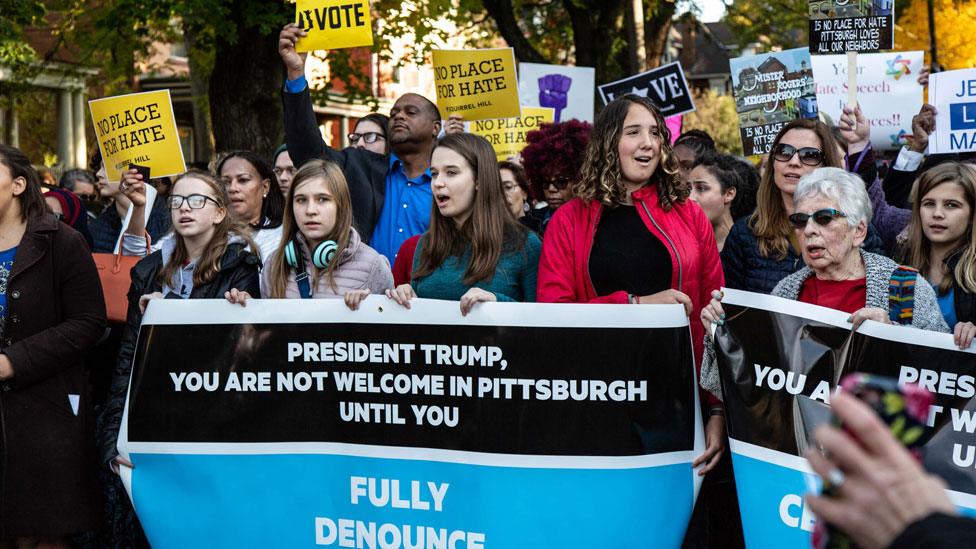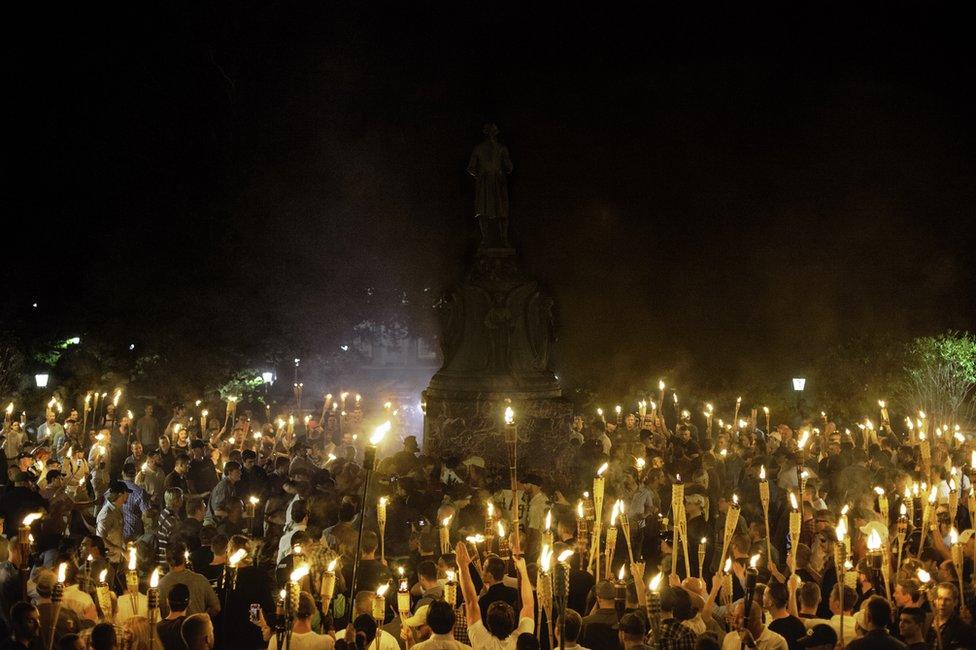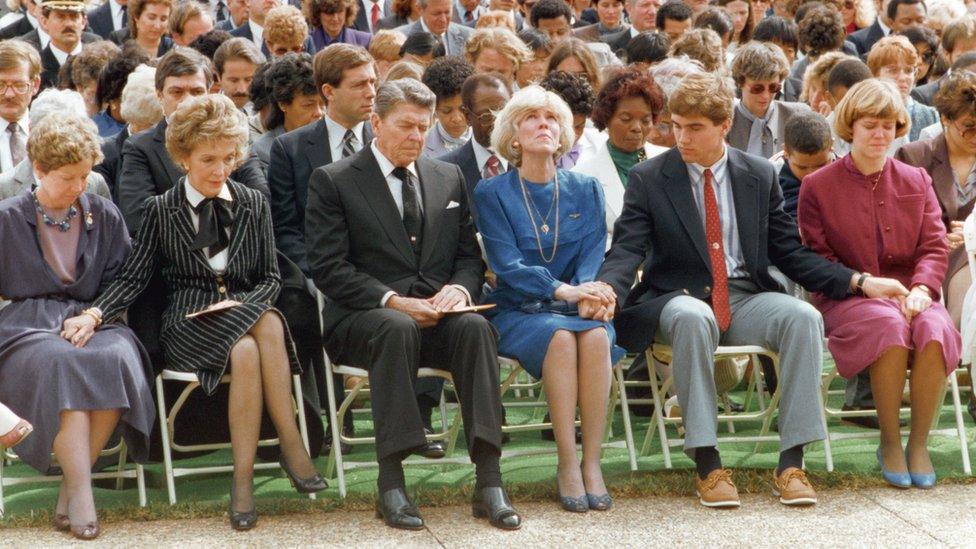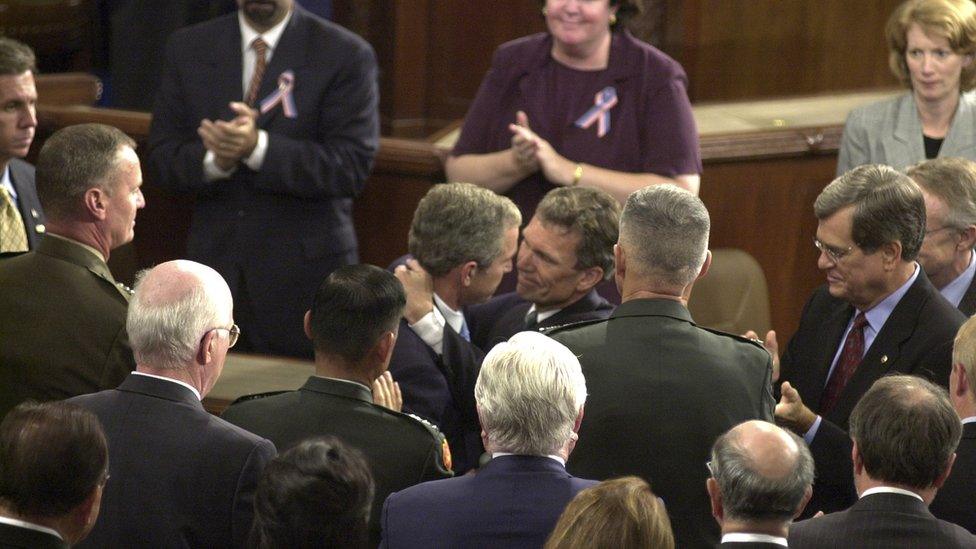At Thanksgiving, discordant Trump heads squabbling American family
- Published

Mocked up picture of Pelosi, Trump and McConnell
The Thanksgiving holidays will provide little respite from rhetoric in a highly polarised US.
In this week of Thanksgiving, a holiday observed by most Americans regardless of creed, ethnicity, gender, age, sexual orientation or politics, it seems untimely to talk of national discord and divisiveness.
However, a shared activity and shared menu of turkey, cranberry sauce and pumpkin pie is something altogether different from a genuine act of commonality. In these angry times, America seems incapable of putting aside its differences, of truly coming together and even of engineering temporary political ceasefires.
Calamitous events are instantly politicised. Even as the death toll continues to mount in California, the wildfires have sparked rancorous debates about forestry policy and global warming. Terror attacks claimed by ISIS are invariably followed by rows about immigration.
Each successive multiple shooting fuels the unending fight between those who believe thoughts and prayers offer an adequate response and those demanding tighter controls on firearms and gun ownership.
The massacre at the Tree of Life synagogue in Pittsburgh last month also shone a light on an alarming rise in anti-Semitism. The Anti-Defamation League reported a 57% spike in anti-Semitic incidents in 2017.

Donald Trump's visit to Pittsburgh, a customary presidential act at such times of bereavement, became contentious rather than communal, with a Jewish social justice group mounting street protests because of his unapologetic embrace of nationalism and his characterisation of some of hate-spewing racists in Charlottesville as "decent people".
This kind of protest, which drew widespread community support, would have been almost unthinkable under most recent presidents. Given the prevailing mood of acrimony, however, and Donald Trump's role in stoking it, it came as no surprise.

A deadly white nationalist rally shocked the nation a year ago in the small city of Charlottesville, Virginia
Even acts of sacred remembrance, such as the recent trip to France to mark the 100th anniversary of the armistice that ended World War One, become needlessly controversial. Prior to Mr Trump heeding the advice of the Secret Service not to travel by motorcade to an American war cemetery when Marine One was grounded by bad weather, a decision seized upon by critics as a dereliction of presidential duty, the trip had already taken an ugly turn.
He arrived in France saying he planned to "celebrate" the end of World War One, a discordant choice of word. The moment Air Force One touched down in Paris, he also picked a fight with his host, the French president Emmanuel Macron. If ever there was a moment to observe a diplomatic ceasefire, surely it was the anniversary of the Armistice.

Read more from Nick

Long before Donald Trump arrived in Washington, the esteemed American political scientist James Q Wilson shrewdly observed: "Once politics was about only a few things. Today, it is about nearly everything."
That dictum seems especially pertinent now. Politics comes to the war cemeteries of France, to American football stadiums on a Sunday afternoon, to the charred cul-de-sacs of Paradise, California, to the National Cathedral in Washington.
When political leaders from both sides gathered there to remember the late Republican Senator John McCain, President Trump was deliberately excluded. John McCain decided before his death that a bipartisan coming together was possible only in the enforced absence of America's head of state, a view widely shared amongst those who packed the pews.
McCain widow - I'll never get over Trump slur
Division, of course, is nothing new. From the country's fractious founding through to the modern-day, this great American experiment has always been explosively combustible. Just visit the Civil War battlefields of Gettysburg, Antietam or Manassas; or the trouble-spots of the civil rights and Vietnam era, such as Birmingham, Selma, and the campuses of "Ole Miss" or Kent State University. The past forty years, if anything, have been relatively peaceable if measured in urban violence, political assassinations or '60s-style mass demonstrations.
But what makes this era so unsettling is the ingrained polarity of the politics.
During the civil rights era, when policy makers in Washington feared the country might be overwhelmed by the racial fury breaking loose in almost every major city, progressive Democrats and moderate Republicans joined forces to defeat segregationist Democrats and unsympathetic Republicans. The 1964 Civil Rights Act, which sounded the death knell for southern segregation, would never have been enacted were it not for bipartisanship.
An incomplete history of protest
Likewise during Watergate, Democrats and Republicans buried their differences to serve the national interest and to avert a full-blown constitutional crisis. Republicans on the House Judiciary Committee joined Democrats in voting to subpoena those incriminating White House tapes. Moderate Republicans helped draft articles of impeachment - though Richard Nixon resigned, of course, before they were put to a full vote of the House of Representatives. The poser of the famed question, "What did the president know and when did he know it?" was not some liberal firebrand but rather Senator Howard Baker, a Republican from Tennessee.
Gone, it seems, is an era when moments of national mourning and commemoration, such as the Challenger space shuttle disaster or the 40th anniversary of the D-Day landings, were politically benign; when a US president could speak on behalf of all of his compatriots, as Ronald Reagan did so memorably on both occasions. But it is also important to point out that the politicisation of national tragedies and convulsions by no means started with Donald Trump.

President Ronald Reagan at the memorial service for the crew of the Challenger space shuttle
Along with the soothing words uttered by Bill Clinton in response to the 1995 Oklahoma City bombing, when 168 people were murdered in a domestic terrorist truck bombing, came an attack on unnamed right-wing figures whom he accused of recklessly stoking anti-government sentiment - the "loud and angry voices in America today," as he put it, "whose sole goal seems to be to try to keep some people as paranoid as possible." It was a valid point to make, but also a highly political one at a time of national grieving. For a president then struggling for relevancy in the aftermath of the Republican Revolution in 1994, Clinton saw in the rubble of the Alfred P Murrah Federal Building a partisan opportunity. The bombing marked the turning point of his troubled first term, and the start of a comeback that culminated two years later in his re-election.
The attacks of September 11th offer another case study. The national unity and patriotic bipartisanship - crystallised on the floor of a joint session of Congress when then-Democratic Senate Majority leader Tom Daschle hugged George W Bush - proved short-lived. In the run-up to the Iraq war, the White House pushed through a war authorisation vote ahead of the 2002 congressional mid-terms, seeking to tag Democrats who opposed it as soft on terrorism. President George Herbert Walker Bush, by contrast, had waited until after the 1990 mid-terms to seek congressional approval for the first Gulf War, a deliberate act of depoliticisation.

Then-President Bush embracing Democratic Senate Majority leader Tom Daschle in the wake of 9/11
What marks out Donald Trump is the speed and apparent relish with which he douses these moments of crisis and mourning with politics. Divisiveness is his default setting, conflict defines his presidency, and though he often pays lip service to national unity in scripted comments and formal statements, his authentic self usually finds quick expression on Twitter. His talent lies in being a partisan attack dog rather than a national consoler.
This month's midterm congressional elections, at which a divided nation produced a divided result, highlighted America's disunity. They reinforced a historic realignment where Democratic strength is now concentrated in the cities and their suburbs, and Donald Trump's America lies beyond.
The political map, rendered in deeper shades of red and blue, looks more partitionist. Almost the entire western seaboard and most of the northeast coastline is now Democratic. On a road trip hugging the Pacific Ocean, you could travel from the southernmost tip of California to the northern-most tip of Washington state and step foot in only one congressional district represented by a Republican. New York City no longer has a single Republican congressman or congresswoman.
Where does America go from here?
Conversely, the landlocked states of America look like a giant red sea, save for a few isolated blue archipelagos.
Though it is an exaggeration to speak of political no-go areas for the Republicans and Democrats, large swathes of the United States resemble one-party fiefdoms. Texas hasn't elected a Democratic Senator since Lloyd Bentsen in 1988. That was also the year California last voted in a Republican Senator. It should come as no surprise that the new Congress convening in January will be the most ideologically polarised in decades.
Donald Trump is not the cause of this disunity. His victory in 2016 was the culmination of a politics that has continually become more wilfully and aggressively partisan. Both Democrats and Republicans have accelerated this trend. His presidency, however, has widened and deepened the breach. His political business model, after all, has long been based aggravating points of cultural, economic and racial contention, whether on birtherism or immigration. At his rallies, he often looks and sounds more like the leader of a cult than the leader of a nation.
As he told rally-goers in West Virginia ahead of the mid-terms, in one of those inadvertently insightful sound-bites he delivers from time to time: "It's so easy to be presidential, but instead of having ten thousand people outside trying to get into this packed arena, we'd have about 200 people."
Can Obama or Trump supporters say one nice thing about opponents?
The problem for Trump is not the ongoing adulation of rally-goers. Even if he shot someone on Fifth Avenue, as he once famously boasted, some would probably not cast off their Make America Great Again caps. It is the wider audience outside. Though his blue-collar base remains solid, and his strength in rural states helped the Republicans retain control of the Senate, the mid-terms became a revolt of white-collar suburban voters. This was especially true of college-educated women, whose unexpectedly high support for him in 2016, even in the aftermath of the Access Hollywood comments, helped him beat Hillary Clinton. For all the polarity, moderates and registered independents can still sway presidential elections.
The mid-terms suggested that the America turned off by Donald Trump is more heavily populated than the America happy with his performance as president. Even in the Senate, where Trump interpreted the results as validation of his leadership, preliminary vote tallies suggest some 45 million Americans cast their votes for Democratic Senate candidate, as opposed to 39.3 million for Republican candidates.
Presidents commonly rebound after mid-term setbacks, as Barack Obama did in 2012 and Bill Clinton did in 1996. Trump's three predecessors were all two-term presidents. The Electoral College means he could lose the popular vote by a heavy margin, as he did in 2016, and still win the White House. Also it would be an act of analytical folly to write him off, a repeat of the colossal mistake so many pundits made in 2016.
However, as the respected political statistician Nate Silver noted earlier this week: "His base alone will not be enough to win a second term."
In 2016, Donald Trump benefited from the politics of division. But this avowed nationalist has struggled to be a truly national leader. The polarisation which fuelled his rise also has the potential to bring about his fall.